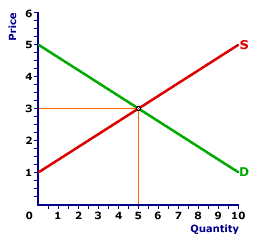A tax wedge is the gap or difference between the demand price and supply price in a market that arises when a tax is imposed on the exchange of a good. Taxes, as mandatory payments from members of society to governments, cause disruptions in normal market exchanges. In particular, the cause differences between demand prices and supply prices.In an efficient, competitive market, free of market control, equilibrium is achieved with equality between the demand price and supply price. At this equality buyers pay the same price that sellers receive. The sellers use this revenue then to pay the myriad opportunity costs of production. However, when a tax is placed on the market, the demand price paid by buyers must cover not only the supply price, the sellers' opportunity costs of production, but also the tax. This difference between demand price and supply price is the tax wedge.
An Efficient Market
| An Efficient Market |  |
To see how a tax wedge is created and disrupts market equilibrium, let's first review market equilibrium for a private good. In the exhibit to the right the market equilibrium is seen by the intersection of the demand curve (D) and supply curve (S). The equilibrium price is $3 and the equilibrium quantity is 5 units.The equilibrium quantity is achieved with equality between the quantity demanded and the quantity supplied. Buyers are able to buy all of the good that they want to buy at the equilibrium price and sellers are able to sell all of the good that the want to sell at the same equilibrium price. Moreover, the demand price that buyers are willing to pay at the equilibrium quantity exactly matches the supply price that sellers are willing to receive at the same equilibrium quantity. Both sides of the market are satisfied with the exchange.
Absent market failures such as market control, externalities, public goods, or imperfect information, then this equilibrium is also efficient. Equality between the demand price and supply price means that the value of the good produced is equal to the value of goods not produced. It is not possible to produce more or less of this good such that society's level of satisfaction increases.
Adding a Tax
However, placing a tax on a market in equilibrium disrupts this equilibrium. If the market is efficient market, then the tax also disrupts the efficiency. Consider how a tax is included in this market. Actual payment of the tax (that is who writes the check to government) can be the responsibility of either buyers or sellers. Sellers might have the responsibility of collecting the tax when the sell the produce (like a sales tax). Or buyers might have the tax payment responsibility, making one payment to the seller for the product, then another to government to cover the tax (like new car registration fees).Whatever the collection process, the consequence for market equilibrium is the same. Buyers end up paying a higher price than sellers receive (or get to keep). This difference in demand price and supply price is the tax wedge.
The easiest way to graphically illustrate a tax wedge is from the supply side of the market -- to treat the tax as a cost of production. While a tax is not really an opportunity cost, from the economy's perspective, if paying the tax is the responsibility of the suppliers, then it can be viewed as a "cost of doing business" for the suppliers. The sellers collect the tax revenue from the buyers, then have the responsibility of making payment to government.
With this approach, we can identify a new "supply" curve that is the original supply curve plus the tax. This works much the same way as a change in the resource prices determinant of supply.
To facilitate the exposition, let's say that a per unit tax of $1 is added to supply. The results are essentially the same if an ad valorem tax is imposed. The result is a new "supply" curve, which lies above and to the left of the original supply curve. This new supply curve, labeled S + T, can be revealed by a click of the [Add the Tax] button. Again, the inclusion of a tax has much the same affect as an increase in any resource price or the cost of production, technically termed a decrease in supply.
The Tax Wedge
One important consequence of this tax is the creation of a tax wedge. That is, the tax drives a "wedge" between the price buyers pay (the demand price) and the price sellers receive (the supply price). The demand price is the price corresponding with the demand curve (D) and the supply price is the price corresponding with the original supply curve (S).To illustrate this tax wedge, click the [Tax Wedge] button. Doing so highlights that a $1 per unit tax effectively creates a $1 difference between the demand price and supply price. This position of this wedge effectively determines the after-tax equilibrium for this market.
TAX WEDGE, AmosWEB Encyclonomic WEB*pedia, http://www.AmosWEB.com, AmosWEB LLC, 2000-2024. [Accessed: April 29, 2024].


